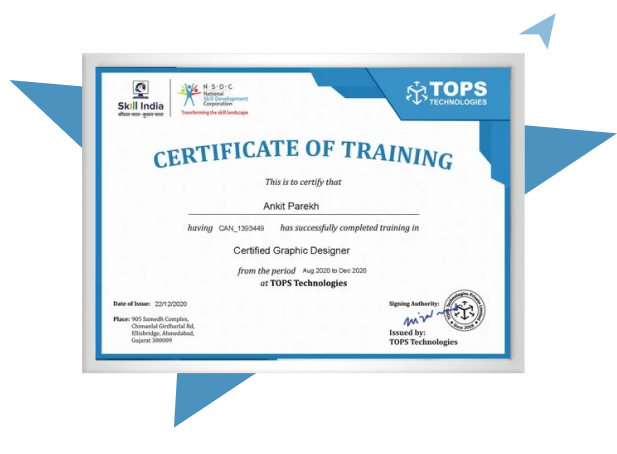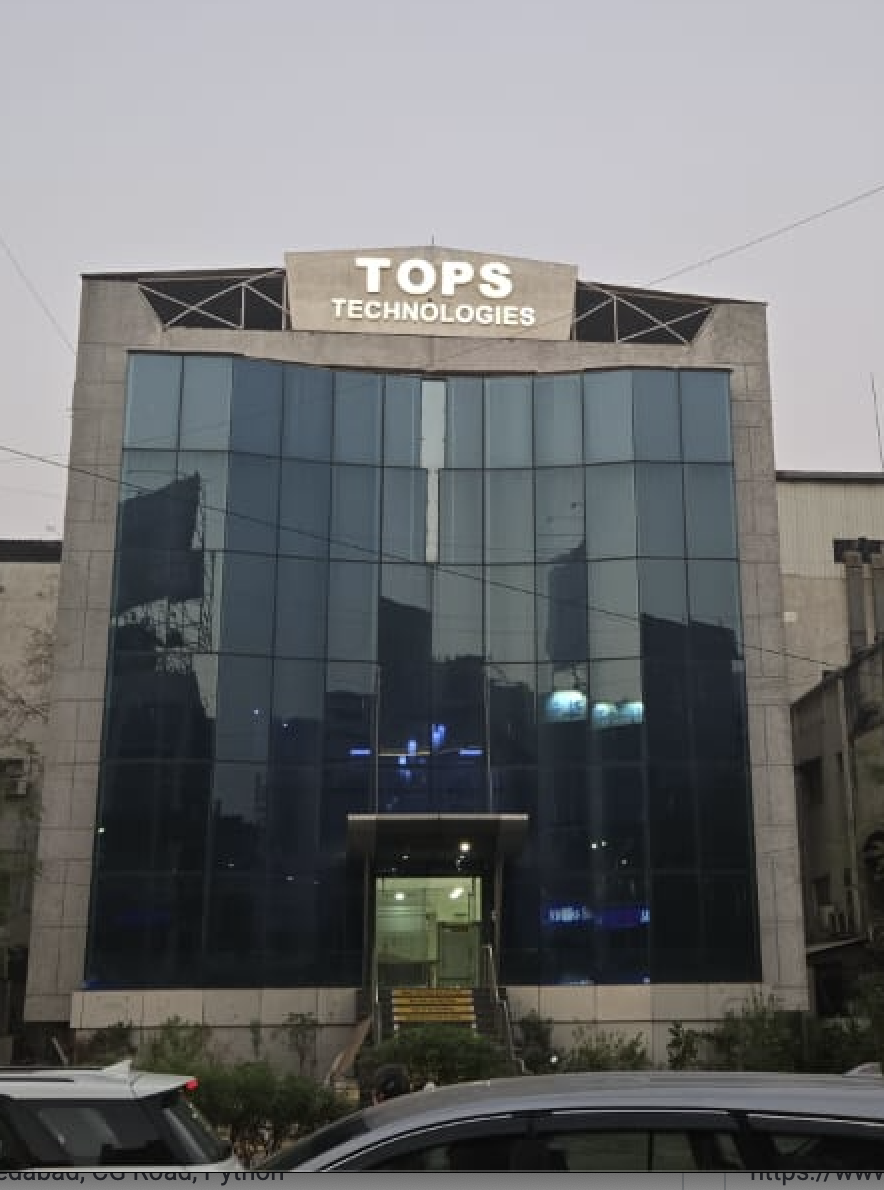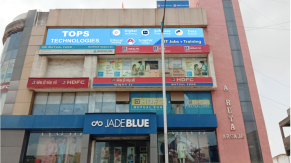Our Facts and Figures
1 Lac+
Student Placed
3000+
Companies TieUp
19+
Offices in India
50+
Industry Courses
Get 100% Job Assistance by enrolling in Certified Java Training Course
Key Highlights
Limited Students Batch
Personalised Attention
Highly Qualified Teachers
Flexible Batch Timings
Interactive Learning
Live Projects
Career Support
Job Oriented Training
Java Course Highlights
Java Training in Gandhinagar for Students & Experienced Pros
Java serves as the base programming language that is required for all mobile application development. It requires more attention to grasp it thoroughly for building a strong base and excel in the field of mobile development. TOPS is well-equipped with quality trainers, who emphasizes on providing ample Java practice courses to students.
With a focus on live practical training with queries, students are trained to solve problems by themselves which in turn helps them to yield better jobs. Visit TOPS Technologies Gandhinagar Training Center to judge the quality training by yourself. Attend a free demo lecture at TOPS to take the right decision for your career.
Customized Java Courses & Classes in Gandhinagar with Experts
TOPS Technologies can extend the learning dimension beyond its institutes as well. We can customize the Java Training Course for students in colleges and for working professionals in offices in Gandhinagar. We also offer online led instructor java coaching, so that you can become certified from your home. For any queries regarding the course, syllabus feels free to email us at inquiry@tops-int.com.
40%
Average Salary Hike
4.5 Lacs
Highest Salary
3000+
Hiring Partners
Join Our Free Upcoming Webinar
Graphic Design with UI / UX
19 Jul 2025, 11:00 AM
Trainer
Gaurav singh tomar
(Sr. Technical Trainer)
All About Full Stack Development
19 Jul 2025, 03:30 PM
Trainer
Rahul Sanghavi CG
(Sr. Technical Trainer)
Want to protect yourself against Malware
19 Jul 2025, 05:00 PM
Trainer
Parag Parmar
(Sr. Technical Trainer)
How to Find the Bug in Manual Testing
20 Jul 2025, 11:00 AM
Trainer
Rahul Sanghavi CG
(Sr. Technical Trainer)
How to Crack the TCS Interview
19 Jul 2025, 02:00 PM
Trainer
Nisarg Jani
(Full Stack Engineer at Cognizant, Ex. System Engineer, TCS)
Java Course Curriculum
Download Curriculum- Introduction to Java
- Introduction of Students Career in IT
- Working on Project and Assignment Using Lab
- Conditional Statements (If, If Else, Nested If Else If) (Switch Case)
- Loops (While, Do While, For)
- Break and Continue
- SDLC Process
- Project Analysis
- Analysis In Details
- DFD(with practical)
- Introduction of DFD
- Rules for Drawing DFD
- Context Level
- First Level
- Second Level
- Data Dictionary
- Flow Chart
- Data Dictionary
- Flow Chart
- Introduction of Core Java
- Eclipse IDE
- JVM,JDK,JRE
- Class, Object, Method
- Constructor
- Garbage Collection
- Finalize
- Source File Layout
- Package Management
- Import Statement
- Data types
- Primitive Types
- Reference Types
- Modifiers- Public, Private, Protected, Default
- Conditional Statements and Looping Statements
- Array Introduction
- Why Array? Advantages
- Types of Array
- Resizing Array
- Copying Array
- Primitive types and Reference type Arrays
- Encapsulations
- Inheritance – Introduction
- Advantages of Inheritance
- Types of Inheritance
- Practical of Inheritance
- Practical of Inheritance with Constructor
- Polymorphism
- Types of Polymorphism
- Method Overloading and Method Overriding
- Abstract and Interface – Introduction and Difference
- Keywords – This, Static, Final, Super
- Classes
- Object Class(only Important Methods)
- String Class (Only Important Methods)
- String Buffer & String Builder
- Wrapper Classes
- Exceptions
- Introduction – Why Exceptions
- Types of Exceptions
- Try catch and Finally Block
- Multi-catch Exceptions
- Throw and Throws keywords
- Method Overriding with Exceptions
- Custom Exceptions
- FILE I/O
- What is Stream and Types of Stream
- File Input Output Streams and Its Methods
- File class
- Command Line Arguments
- Thread-Introduction
- Thread Life Cycle
- Creating Threads
- Thread Class Methods (Only Important Methods)
- Runnable Interface
- Synchronized block and Synchronized Methods
- Collection Framework – Introduction
- Collection API
- Hierarchy of Collections
- List and Set and Map Collections
- Array list, vector, and Other Classes
- Generics
- Comparator and Comparables
- JAVA GUI
- AWT (Introduction only) & Swing (in Details)
- Components, Containers, Frame, Window, Panel, Layout
- All Components
- Events, Event Handling
- Database
- DDMS and RDBMS
- Introduction
- MYSQL
- MYSQL IDE
- Query Types
- DDL,DML,DQL, DCL
- Constraints
- Primary Key
- Foreign Key
- Unique Key
- Normalizations
- 1NF
- 2NF
- 3NF
- Joins
- All Joins Types
- Advance Database
- Indexers
- Views
- Procedures
- Functions
- Cursor
- Triggers
- JDBC (Insert, Update, Select, Delete)
- Introduction of JDBC
- Driver Types
- Steps for Creating Connections
- Types of Statements (Statements, prepared Statements and Callable Statements)
- Result Set Interface
- Database Metadata
- Result Set Metadata
- HTML
- UL Tag
- LI Tag
- a Tag
- IMG tag
- Table, TR, TD tag
- Form tags with Attributes
- All input tags
- CSS
- Types of CSS
- Pseudo- Classes
- Margins and Puddings
- CSS background
- CSS using ID and Class
- JavaScript
- Events
- Validations
- Validations with Regular Expressions
- Firebug
- Template Integration
- Introduction of Client-Server Architecture
- HTTP Protocol overview with Request and Response header explanation
- J2EE Architecture Overview
- Web Component Development In Java
- CGI Programming Process Advantage and Disadvantage
- Servlet Programming Introductions
- Advantage and Disadvantage
- Servlet Versions
- Types of Servlets
- Difference between HTTP Servlet a Generic Servlet
- Servlet Life Cycle
- Creating Servlets
- Servlet Entry in web.xml
- Logical URL
- Servlet Config Interface
- Request Dispatcher Interface
- Forward and Include Methods
- Servlet Context Interface
- Web Application Listener
- Scope of Objects, Request, and Response
- Application (Context) , Config
- Java Filters – Introduction
- What are the needs
- Filter Life Cycle
- Process of Execution Filter
- Applying Filter
- Entry in web.xml
- URL Pattern with Filter
- JSP Introduction
- JSP Translation
- JSP Life Cycle
- Comments
- Directives
- Scrip lets
- Expression
- Declaration
- Implicit Objects
- Action
- JSTL
- Custom Tags
- Session Management – Introduction
- What are the needs?
- Session Tracking Technique
- Hidden Form Fields
- URL Rewriting
- Cookies
- Session
- Design Pattern
- MVC Design Pattern with Example
- AJAX Programming With Example
- Introduction to Distributed Technologies
- RMI, EJB and WEB Services Introduction
- Types of web services
- What is Restful Web Services?
- Restful Web Services Annotations
- Restful Web Services with Example
- Hibernate Introduction
- Hibernate Architecture
- Hibernate Configuration
- All Core Interface
- Query and Criteria
- Named Query
- All Relationships
- One to One
- One to Many
- Many to One
- Many to Many
- All Database Operations with hibernate
- Overview Of Spring Framework
- Introduction of Spring Framework Architecture
- Core Container
- AOP (Aspect Oriented Programming)
- Spring DAO (Data Integration)
- Web
- Spring Using IDE
- Using Library
- Spring Hello World Example
- Spring IOC Container
- Bean Factory
- Application Context
- Spring Bean Definition
- Configuration
- Life Cycle
- Inheritance
- Scopes
- Spring Dependency Injection
- Constructor-based
- Setter Getter based
- Inner Beans, Aliases, and ID-ref
- Collections and References
- Auto Wiring
- Spring AOP
- AOP Term
- Write the Aspects
- Configure Where the Aspects
- Spring ORM
- Spring MVC Web Forms
- Spring Form Handling
- Spring Form Tags
- Spring Controller XML and Annotation Based
- Spring MVC with Session Management
- Spring CRUD Operation using Hibernate ORM
- Cloud Computing – Introduction
- Types
- Hosting
- The Project Definition for this Java Live Project was an Online News Portal. It allows the News publisher to publish his news and the user can select the news he wants to read. The project was developed using cutting edge technology in Java using advance
- This Live project was rated as the best java project ideas was built in Java and allows a user to find cheap and efficient parking in and around where the user is. The system using gps tracking on the mobile phone and finds the most effective parking spot
- This Java Project was built for the government java course admission process. The student Management system allows the tracking of all the students, their daily attendance, Java Classes, Java Certification grades. All the information about Java Training i
Our TOPS Training Centers in India
Course Key Features
Skills Covered
Job Roles
Get Training Certificate by Government
Recognized NSDC/Skill India

- National Skill Development Corporation
- Supported by the vision of PM Shri Narendra Modi
- Certification by NSDC SkillIndia
- Valid for all Jobs and College Training
- International Recognition

FAQ
Java remains one of the most in-demand programming languages in the IT industry. After completing the course, students can apply for roles such as:
- Java Developer
- Backend Developer
- Web Application Developer
- Android Developer (with additional mobile development skills)
- Software Engineer
- Junior Full Stack Developer
- These roles span across industries such as finance, healthcare, e-commerce, IT services, and startups.
Yes. Interview readiness is a major focus at TOPS. Students undergo regular assessments, participate in mock interviews (technical + HR), group discussions, and receive one-on-one mentoring. They are trained to solve Java coding challenges, write clean code, and answer scenario-based questions confidently..
The course follows a 70% practical and 30% theoretical structure. Core concepts are introduced theoretically, followed by live demonstrations, coding sessions, assignments, and mini-projects. This ensures students can not only understand but also apply what they learn in real-time scenarios
Yes. Upon successful completion of the course and final project, students receive a course completion certificate from TOPS Technologies. This certificate validates their knowledge and skills and can be included in resumes and LinkedIn profiles. In addition, students are guided to prepare for external certifications like Oracle Certified Associate (OCA).
Yes, the Java course is tailored for students of all levels. Beginners start with basic programming concepts and gradually move toward advanced topics. Trainers provide hands-on practice, real-life examples, and one-on-one doubt-solving sessions to ensure that every student, irrespective of background, can understand and implement Java concepts effectively.
There are no strict prerequisites. While prior programming knowledge is a plus, it is not required. The course begins with fundamentals and is structured to guide even those with zero coding experience. Basic computer literacy and logical thinking are sufficient to start the course.
Yes. Project-based learning is a major part of the Java training. Students work on live projects such as library management systems, e-commerce applications, employee payroll systems, or customer relationship management (CRM) tools. These projects simulate real-world scenarios and help students gain practical skills required in the industry.
Yes. TOPS Technologies has a dedicated placement cell that works with 3000+ partner companies. Students receive resume-building support, mock interviews, aptitude training, soft skills coaching, and regular job placement drives. Many students secure internships or full-time jobs shortly after course completion.
Students become proficient in tools and IDEs like Eclipse, IntelliJ IDEA, and NetBeans. For backend development, they learn to work with MySQL or PostgreSQL databases and tools like XAMPP or phpMyAdmin. They also use Postman for API testing and version control tools like Git.
After completing the Java course, you can apply for roles like:
- Java Developer
- Backend Developer
- Software Engineer
- Web Application Developer
- Android Developer (with Java knowledge)
Interview Questions
Polymorphism in Java refers to the ability of objects of different classes to be treated as if they are of the same class. An example is a superclass Animal with a method makeSound() that is overridden by subclasses Dog and Cat.
You can implement a merge sort algorithm in Java using recursion and a merge method to combine two sorted arrays.
There are two types of exceptions in Java: checked exceptions and unchecked exceptions. Checked exceptions are checked at compile time, while unchecked exceptions are checked at runtime. Examples of checked exceptions include IOException and ClassNotFoundException, while examples of unchecked exceptions include NullPointerException and ArrayIndexOutOfBoundsException.
A HashSet is an unordered collection of unique elements, while a TreeSet is a sorted collection of unique elements.
You can implement a Stack using an Array by maintaining a pointer to the top of the stack and pushing and popping elements from the top of the array.
A shallow copy creates a new object with the same reference as the original object, while a deep copy creates a new object with a new reference.
You can reverse a linked list in Java by iterating through the list and reversing the order of the links between nodes.
A String is immutable, while a StringBuilder and StringBuffer are mutable. StringBuilder is not thread-safe, while StringBuffer is thread-safe.
A binary search tree is a data structure in which each node has at most two children, and the left child is smaller than the parent while the right child is larger. You can implement one in Java using recursion and comparison operators.
You can handle multiple exceptions in Java using a try-catch block with multiple catch clauses.
Latest Blogs
Everything You Need To Know About Java
Do you want to do a Java course? Java has been popular among tech developers over the past few years...
View full BlogWhy Has Java Become So Popular?
Java is a very effective programming language that is utilized by millions of individuals all around...
View full BlogTips & Tricks to Learn Java Efficiently
With the world growing increasingly digital, the demand for skilled programmers is on the rise. This...
View full BlogBust Common Myths about Java Programming
Not sure if enrolling for a Java training course will keep you relevant in the current industry? The...
View full Blog








